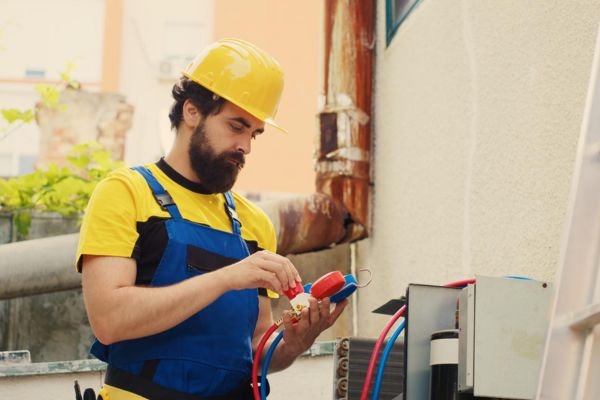Selling a home is part math, part psychology. The water heater sits right at that intersection: it’s a relatively small mechanical system compared to a roof or HVAC, but it has an outsized impact on buyer confidence, inspection outcomes, and negotiation leverage. So does replacing a water heater increase home value? In many cases, yes, but the value often shows up indirectly: faster offers, fewer repair credits, and stronger contract terms. When done strategically, it can also contribute to a higher contract price, especially in markets where buyers expect modern, efficient systems.
Let’s unpack when replacement makes financial sense and how to maximize the return.

Why Your Water Heater Matters to Buyers and Appraisers
First impressions and buyer confidence
Buyers love “turn-key.” A fresh, code-compliant water heater with visible documentation (permit, installation date, warranty) signals a well-maintained home. An older, rust-ringed tank with scorch marks or a taped-up T&P discharge pipe triggers doubts about the rest of the property.
How inspectors treat aging water heaters
Home inspectors routinely flag water heaters nearing the end of their typical lifespan. Even if it’s still working, expect language like “near end of expected life” or “recommend budget for replacement.” That note often becomes a bargaining chip for buyers seeking a closing credit.
Direct vs. Indirect Value—What Actually Moves Your Sale Price
Direct value: comparable sales and appraisals
Appraisers primarily look at comparable sales (comps). A new water heater alone rarely justifies a big adjustment to the appraisal unlike a new roof or full HVAC swap. But it can support overall condition ratings and help your home stack up better against similar listings.
Indirect value: faster sale, fewer concessions, stronger offers
Where water heaters shine is in avoiding repair credits, reducing days on market, and improving offer quality. If a buyer doesn’t need to budget for a $1,500–$3,500 replacement (typical installed ranges vary by region and system type), they may offer closer to list or bid more aggressively in competitive markets.
Typical Costs and Potential ROI (Back-of-the-Envelope)
Replacement cost ranges (tank vs. tankless)
- Standard tank (gas or electric): commonly $900–$2,500 installed, depending on size, location, code upgrades, and permits.
- Tankless (gas or electric): commonly $2,000–$5,500 installed, influenced by venting, gas line sizing, and electrical requirements.
Note: Prices vary by region, brand, capacity, and complexity. Always compare local quotes.
READ MORE: Should I Replace My 13-Year-Old Water Heater?
Example ROI scenarios
When ROI is positive
- Your current unit is 12–15+ years old (or failing).
- Inspections would likely trigger a $1,000–$3,000 repair credit request.
- You replace for $1,400, market “New 2025 high-efficiency unit, transferable warranty,” avoid credits, and boost buyer confidence.
- Net effect: You’ve effectively protected price and possibly reduced time to close—often a stronger outcome than last-minute credits.
When ROI is neutral but still smart
- Hot seller’s market, limited inventory.
- Old tank works fine, but looks rough.
- Replacement may not lift the appraisal much, but it can prevent renegotiations and keep the deal clean valuable if you’re juggling a tight timeline or a contingent purchase.
Signs You Should Replace Before Listing
Age and remaining lifespan
- Conventional tank: Typically 8–12 years. Over 10 years? Buyers and inspectors will watch closely.
- Tankless: Often 15–20 years with maintenance. Past 15 years? Similar scrutiny.
Reliability red flags
- Rust on the base or around fittings
- Water around the tank, damp pan, or corrosion on the T&P valve
- Inconsistent hot water or banging/rumbling noises
- Repeated pilot or ignition failures
Energy efficiency gaps buyers will notice
If neighboring comps highlight efficiency ENERGY STAR models, recirculation for faster hot water, or tankless systems your dated unit can look like a future expense. Upgrading narrows that gap.
READ MORE: What to Do When a Water Heater Leaks
When You Might Not Need a Full Replacement
Strategic repairs
If the unit is mid-life and healthy, fix small issues: replace the T&P valve, swap a failing thermocouple, or repair a minor leak at fittings. A safe, code-compliant unit won’t derail a sale.
Maintenance refresh that signals care
- Flush sediment (especially in hard-water areas)
- Replace the anode rod if age allows
- Insulate hot water lines where appropriate
- Secure earthquake straps (where required)
- Ensure the drain pan and discharge line are correct and visible
Disclosure and pricing strategy
If you choose not to replace an aging unit, price accordingly and disclose proactively. Some sellers simply offer a home warranty that covers water heater failures for the first year; this can neutralize buyer anxiety at modest cost.
Tank vs. Tankless—Which Adds More Market Appeal?
Pros and cons that matter at resale
- Tankless (pros): Continuous hot water, space-saving, often higher efficiency, long lifespan.
- Tankless (cons): Higher upfront cost, potential gas/electrical upgrades, buyers unfamiliar with maintenance may hesitate.
- Tank (pros): Lower cost, familiar to everyone, quick replacement.
- Tank (cons): Shorter lifespan, standby heat loss, bulkier footprint.
How local market norms influence value
In neighborhoods where tankless is common, not having one may look dated. In areas where standard tanks dominate, a new, efficient tank is usually enough to reassure buyers. Match market expectations to avoid overspending.
READ MORE: What Trips the Reset Button on a Hot Water Heater?
Energy Efficiency, Rebates, and the Marketing Boost
Lower utility bills as a selling point
Energy costs are a recurring buyer concern. A modern, efficient unit can reduce monthly bills use that in your listing: “New 2025 high-efficiency water heater for lower utility costs.”
Leveraging rebates, warranties, and certifications
- Save and display rebate paperwork (utility or government).
- Highlight manufacturer warranty (transferable if applicable).
- If installed by a licensed pro with permits, state that clearly: “Permitted and inspected installation in August 2025.”
What Real Estate Pros Look For
Appraisers and “functional utility”
Appraisers rarely add large line-item value for a single appliance, but a brand-new heater can support overall condition and functional utility helpful nudges when comps are tight.
Agents on buyer psychology
Agents know the short list of items that spook buyers: roof, foundation, HVAC, water heater. Removing one worry often translates into cleaner offers and fewer post-inspection price cuts.
Pricing Strategy: How to Capture the Value of a New Heater
Positioning in listing copy
Use plain, punchy language:
- “New 50-gal high-efficiency gas water heater (installed 2025), permits and warranty on file.”
- “Tankless water heater—endless hot showers and lower energy use.”
Negotiation leverage and avoiding credits
If you replace pre-listing, you’re less likely to see a $1,000–$3,000 “just-to-be-safe” credit request from buyers after inspection. That alone can preserve more net proceeds than trying to squeeze out an extra 0.5–1% on price.
Pre-List Checklist if You Decide to Replace
Sizing and fuel type
- Match or thoughtfully upsize (e.g., 40 → 50 gallons) for family appeal.
- Tankless? Ensure adequate GPM for simultaneous showers and laundry.
- Pick gas vs. electric based on existing infrastructure to avoid costly upgrades unless efficiency gains justify it.
Permits, code, and placement
- Pull permits where required.
- Confirm venting, clearances, expansion tank, seismic strapping (where required), correct T&P discharge.
- If the old unit was tucked into a tough space, improving the placement can impress inspectors and buyers.
Documentation to keep
- Invoice with model and serial number
- Permit and final inspection (if applicable)
- Warranty (and transfer steps)
- Any rebate approvals
READ MORE: AO Smith Water Heater Reviews
Common Mistakes to Avoid
Overspending relative to comps
Dropping $4,000+ on a premium tankless in an entry-level neighborhood full of basic 40–50 gal tanks may not return its cost. Align with buyer expectations for your price bracket.
Choosing niche systems for mainstream buyers
Exotic or complex setups can intimidate. If most buyers in your area want simple and reliable, prioritize mainstream brands and straightforward operation.
Quick Math: A Simple Framework to Decide
Cost vs. credit risk
Estimate the likely buyer credit if you don’t replace (often $1,000–$3,000 on an old unit). If your replacement cost is equal or lower especially with better marketing and a smoother close the decision often leans replace.
Time-to-sell considerations
If your goal is speed, removing an inspection hurdle helps. If you’re in no rush and inventory is tight, you might hold off unless the unit is visibly failing.
Rule of thumb:
- Old and shabby? Replace.
- Mid-life and healthy? Maintain and document.
- Neighborhood expects modern systems? Upgrade (possibly tankless).
- Budget tight? Consider warranty + disclosure instead.
Case Studies (3 Scenarios)
Hot seller’s market—minimal direct value, strong speed
- 10-year-old 40-gal tank, still working.
- You’re fielding multiple offers already.
- Replacement won’t change appraisal much, but a quick swap pre-listing avoids a credit request and keeps the best buyer engaged.
Outcome: Faster, cleaner closing indirect value wins.
Balanced market—moderate ROI
- 12-year-old tank with rust near fittings.
- Replace with a mid-range 50-gal high-efficiency unit for ~$1,500.
- Market it in the listing; appraiser notes overall condition as “updated.”
Outcome: You avoid a $1,500 credit, attract stronger offers, and possibly nudge the final price upward.
Buyer’s market—high leverage vs. repair credits
- 14-year-old tank, known ignition issues.
- If left alone, expect buyer to demand $2,000–$3,000 credit.
- Replacement at $1,600 removes an objection and broadens your buyer pool.
Outcome: You spend less than the likely credit, reduce days on market, and keep more control in negotiations.
Final Verdict
Replacing an old water heater can increase your home’s perceived value and often your net proceeds, but the “raise” may not be a neat line on an appraisal. The real financial gain is usually in preventing repair credits, improving buyer confidence, and speeding up the sale. If the unit is aged, looks rough, or likely to be flagged by inspection, replacement is a smart pre-list investment. If the unit is mid-life and healthy, maintenance plus smart disclosure may be enough. Align your decision with neighborhood norms, your timeline, and how sensitive your market is to mechanical system updates.
FAQs
1) Does a brand-new water heater add the same value as a new roof or HVAC?
No. Roofs and full HVAC systems typically carry more weight in appraisals. A new water heater, however, meaningfully improves buyer confidence and can avoid costly credits which often benefits your bottom line.
2) Is tankless always better for resale?
Not always. Tankless can be a great selling point in markets that expect it, but in areas where standard tanks dominate, a new efficient tank may offer the best cost-to-benefit ratio.
3) Should I replace an 8-year-old heater before selling?
It depends on condition. If it’s well-maintained, code-compliant, and not leaking, a maintenance refresh plus clear documentation may be enough. If it shows rust, leaks, or fails inspection, replace to avoid credits.
4) How do I show buyers the value of a new water heater?
Include installation date, model, efficiency rating, permit/inspection, and warranty in your listing and on the counter during showings. Use concise, benefit-driven language (“lower utility costs,” “endless hot water”).
5) What if I can’t afford replacement before listing?
Offer a home warranty that covers the water heater for the buyer’s first year, disclose the age/condition openly, and price accordingly. This often neutralizes concerns without a large upfront expense.

